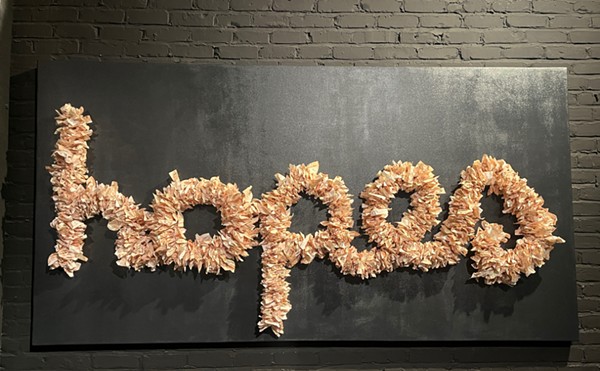I’m a total skeptic when it comes to “art star” juried exhibitions. They’re too often more about celebrity drawing power than about the artists being shown. What’s more, I’m not a huge Mike Kelly fan, although I appreciate his stature in the international art world, especially since he’s a Motown homeboy. (Actually, I like the idea of his art, with its origins in the wretchedness of America’s postindustrial suburban wasteland and the resistance to the lameness of it all as expressed in low and popular culture; it’s the execution that disappoints me.) That’s why I was doubly surprised by this show. First, the overall quality is high. Second, it’s varied yet cohesive, a testament to Kelly’s aesthetic judgment.
Any juried exhibition is only as good as what’s been submitted, reduced by the juror’s ability to judge unfamiliar work for which he or she may (or may not) have empathy. Selection usually takes place in less-than-ideal circumstances, often squeezed in between lectures and other personal commitments, or it’s done quickly from slides. Kelly worked from slides, selecting 11 artists from some 125 entries. But according to Detroit Artists Market Director Aaron Timlin, he took more than a month to look at the work — and it shows.
Five of the 11 artists are from out of state, so the show can’t be said to represent a “Detroit” sensibility. In fact, Kelly notes in his juror’s statement that he tried to choose artists who reflect international trends. And while he says he saw a lot of Cass Corridor-style work in the slides, he didn’t pick any of it. Instead, he selected artists who mine many of the aesthetic veins he has prospected since leaving Michigan some 30 years ago. Kelly’s Whitney Museum retrospective a few years back was titled “Catholic Tastes,” conveying a sense of both his working-class Irish background and the breadth of his artistic temperament. And Kelly’s catholic bent is the key to understanding this show.
One aspect is the use of unusual materials, especially those associated with consumer culture. Noelle Allen of Chicago has three pieces made from spun sugar. Arachnograph I and Arachnograph II are what the titles suggest, delicate spider web forms on Mylar. The third, Husk, is the best, consisting of a large cocoon of spun sugar on an acrylic rod hanging inside a display case. As the spun sugar has condensed, the cocoon has collapsed in on itself, bending the acrylic rod under its tacky weight. A sickly sweet pile of the material has built up on the bottom of the display as it has dripped down over time.
Another aspect of Kelly’s catholic taste is the influence of comics and pulp fiction. Mariano Chavez, also of Chicago, is represented by two small paintings that combine digital printing and oil paint, mixing contemporary and traditional media. Troll Cave Painting has turd-like brownish stalactites dripping down and stalagmites piling up, framing the head of a demented Sambo-esque Neanderthal who sports two teeth and a Carmen Miranda headdress. It could have been part of an installation Kelly once did based on Plato’s allegory of the cave, using low culture to denigrate the high ideals of philosophical rationality. Pennsylvanian Tom Costa’s oil paintings of scenes of the uncanny are also of this variety.
The obsession with religion comes through in Grosse Pointer Alison Sparrow’s Blue Crucifixion. In the painting, a virginal girl prays on the left hand side of the canvas behind a chalice, doves, and some apples (the latter metaphors no doubt of Eve and original sin) with a Pan-like figure of earthly temptation on the right and the crucified savior in between. It’s a kinder, gentler version of Kelly’s Pants Shitter and Proud, an ode to abjection based on memories of making church banners as a catechism project.
The garishly lit Cibachrome photographs of young urban hipsters, taken by Tiffany Bolk of Hamtramck, are the only things in the show that Kelly readily identifies with Detroit. Thrift-store chic mise-en-scènes and retro-moderne attitudes pervade Bolk’s images, such as We Needn’t Worry About That, a portrait of a couple luxuriating under a crimson quilt, toking on a hookah, with a cat stalking the foreground. (Recycling trash is another Kelly obsession; examples from his collection of sock monkeys and castoff plush toys adorn the cover of Sonic Youth’s 1992 release Dirty.) Where Nan Goldin’s better-known photos of her New York East Village friends play up the bathetic pose, Bolk’s Detroiters embrace camp and are far more self-aware (and quite frankly more truly postmodern) as a result.
This show may not convince you to see the light on Kelly as an artist if you’re not already so inclined. However, it may persuade you to take a closer look at those working in his shadow.
Mike Kelly Selects runs until July 18 at Detroit Artists Market, 4791 Woodward Ave. (at Forest) in Detroit’s Cultural Center. Gallery hours: Wednesdays-Sundays, 11 a.m.-6 p.m. Call 313-832-8540.
Vince Carducci writes about art for Metro Times. E-mail [email protected]




